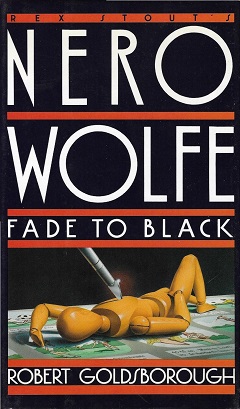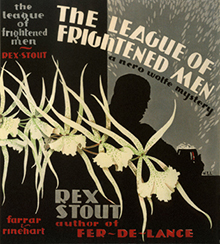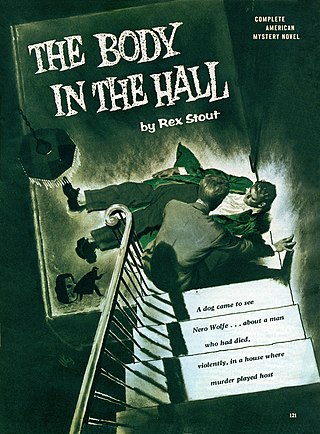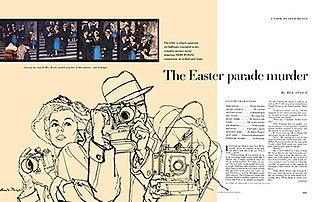
Nero Wolfe is a brilliant, obese and eccentric fictional armchair detective created in 1934 by American mystery writer Rex Stout. Wolfe was born in Montenegro and keeps his past murky. He lives in a luxurious brownstone on West 35th Street in New York City, and he is loath to leave his home for business or anything that would keep him from reading his books, tending his orchids, or eating the gourmet meals prepared by his chef, Fritz Brenner. Archie Goodwin, Wolfe's sharp-witted, dapper young confidential assistant with an eye for attractive women, narrates the cases and does the legwork for the detective genius.

Archie Goodwin is a fictional character in a series of detective stories and novels by American author Rex Stout. Archie is the witty narrator of the cases featuring his boss, Nero Wolfe, from 1934 (Fer-de-Lance) to 1975. Although his job title is Wolfe's secretary and chauffeur, Archie is effectively Wolfe's partner in the detective business, and the stories often contrast his middle class streetwise persona with Wolfe's aristocratic intelligence.
The Nero Wolfe stories are populated by a cast of supporting characters who help sustain the sense that each story takes place in familiar surroundings. The main characters are Nero Wolfe and Archie Goodwin.

Fade to Black is a Nero Wolfe mystery novel by Robert Goldsborough, the fifth of seventeen Nero Wolfe books extending the Rex Stout canon. It was first published by Bantam in hardcover in October 1990.

In the Best Families is a Nero Wolfe detective novel by Rex Stout, first published by the Viking Press in 1950. The story was collected in the omnibus volumes Five of a Kind and Triple Zeck.

Fer-de-Lance is the first Nero Wolfe detective novel written by Rex Stout, published in 1934 by Farrar & Rinehart, Inc. The novel appeared in abridged form in The American Magazine under the title "Point of Death". The novel was adapted for the 1936 film Meet Nero Wolfe, and it was named after a venomous snake with the same name. In his seminal 1941 work, Murder for Pleasure, crime fiction historian Howard Haycraft included Fer-de-Lance in his definitive list of the most influential works of mystery fiction.

The League of Frightened Men is a 1937 American mystery film based on the 1935 novel of the same name, the second Nero Wolfe novel by Rex Stout. Directed by Alfred E. Green, the Columbia Pictures film stars Walter Connolly as Nero Wolfe, a role played by Edward Arnold in the previous year's Meet Nero Wolfe. The role of Wolfe's assistant Archie Goodwin was reprised by Lionel Stander.

The League of Frightened Men is the second Nero Wolfe detective novel by Rex Stout. The story was serialized in six issues of The Saturday Evening Post under the title The Frightened Men. The novel was published in 1935 by Farrar & Rinehart, Inc. The League of Frightened Men is a Haycraft Queen Cornerstone, one of the most influential works of mystery fiction listed by crime fiction historian Howard Haycraft and Ellery Queen.

The Rubber Band is the third Nero Wolfe detective novel by Rex Stout. Prior to its publication in 1936 by Farrar & Rinehart, Inc., the novel was serialized in six issues of The Saturday Evening Post. Appearing in one 1960 paperback edition titled To Kill Again,The Rubber Band was also collected in the omnibus volume Five of a Kind.

If Death Ever Slept is a Nero Wolfe detective novel by Rex Stout, published by the Viking Press in 1957 and collected in the omnibus volume Three Trumps.

Death of a Doxy is a Nero Wolfe detective novel by Rex Stout, first published by Viking Press in 1966.

Nero Wolfe is an American drama television series based on the characters in Rex Stout's series of detective stories. The series aired on NBC from January 16 to August 25, 1981. William Conrad fills the role of the detective genius Nero Wolfe, and Lee Horsley is his assistant Archie Goodwin. Produced by Paramount Television, the series updates the world of Nero Wolfe to contemporary New York City and draws few of its stories from the Stout originals.

"Cordially Invited to Meet Death" is a Nero Wolfe mystery novella by Rex Stout, first published in abridged form as "Invitation to Murder" in the April 1942 issue of The American Magazine. It first appeared in book form in the short-story collection Black Orchids, published by Farrar & Rinehart in 1942.
"Counterfeit for Murder" is a Nero Wolfe mystery novella by Rex Stout, first serialized as "The Counterfeiter's Knife" in three issues of The Saturday Evening Post. It first appeared in book form in the short-story collection Homicide Trinity, published by the Viking Press in 1962.

"Before I Die" is a Nero Wolfe mystery novella by Rex Stout, first published in the April 1947 issue of The American Magazine. It first appeared in book form in the short-story collection Trouble in Triplicate, published by the Viking Press in 1949.

"The Next Witness" is a Nero Wolfe mystery novella by Rex Stout, first published as "The Last Witness" in the May 1955 issue of The American Magazine. It first appeared in book form in the short-story collection Three Witnesses, published by the Viking Press in 1956.

"Die Like a Dog" is a Nero Wolfe mystery novella written by American writer Rex Stout, first published as "The Body in the Hall" in the December 1954 issue of The American Magazine. It first appeared in book form in the short-story collection Three Witnesses, published by the Viking Press in 1956.

"Easter Parade" is a Nero Wolfe mystery novella by Rex Stout, first published as "The Easter Parade Murder" in the April 16, 1957, issue of Look magazine. It first appeared in book form in the short-story collection And Four to Go, published by the Viking Press in 1958.

This is a bibliography of fiction by and works about Rex Stout, an American writer noted for his detective fiction. He began his literary career in the 1910s, writing more than 40 stories that appeared primarily in pulp magazines between 1912 and 1918. He then wrote no fiction for more than a decade, until the late 1920s, when he had saved enough money through his business activities to write when and what he pleased. In 1929, he wrote his first published book, How Like a God, an unusual psychological story written in the second person. He wrote a pioneering political thriller, The President Vanishes (1934), before specializing in detective fiction. His 1934 novel Fer-de-Lance introduced his best-known characters, detective Nero Wolfe and his assistant Archie Goodwin, who were featured in 33 novels and 41 novellas and short stories between 1934 and 1975. In 1959, Stout received the Mystery Writers of America's Grand Master Award. The Nero Wolfe corpus was nominated as Best Mystery Series of the Century at Bouchercon XXXI, the world's largest mystery convention, and Rex Stout was nominated as Best Mystery Writer of the Century.
The Wolfe Pack is a literary society devoted to Rex Stout's character Nero Wolfe.

















